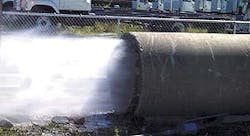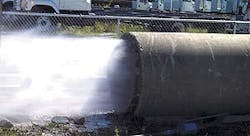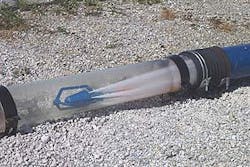Line Cleaning Helps Smooth Sewer Flow
Combination sewer and catch basin cleaners are designed to clean sanitary and storm sewer lines using high-pressure water to flush debris through the lines while simultaneously vacuuming the debris and water from a catch basin or manhole. Depending on the type of debris and line, there are many factors that need to be considered to safely, effectively clean and maintain storm or sewer lines.
Factors that should be considered for anyone who is cleaning or maintaining their city's lines include the type of line (sewer or storm), type of jetting nozzle and nozzle head, the nature of sediment, as well as components such as the hose and pump. Many times, line cleaning can be a test in trial and error. But having general information and guidelines can help alleviate some of the guesswork.
Many of the factors involved in this process will likely change from one line application to the next. And because there are no clear-cut steps that work for every situation and every line, this article will offer suggested guidelines to assist operators in taking into account the factors that should be studied in order to quickly and efficiently clean and maintain sewer and storm lines.
Different Conditions, Different ApproachesWhether you are trying to jet-clean sewer or storm lines of sludge, leaves, gravel, sand, garbage, grease, hardened debris, solid wastes, or blockages, adequate water pressure and flow are necessary to clean the line effectively. Selecting the best nozzle and components for a particular application is a crucial part of the process.Different conditions will demand different nozzles. Whether cleaning and servicing small lines or extra large storm lines, a few guidelines may be helpful to keep in mind.
In general, when cleaning and maintaining storm lines, a larger nozzle is used and the jets are often placed on the nozzle's underside. This is ideal for cleaning material on the bottom of a line. Because storm lines typically collect material such as rocks, sand, bottles, cans, dirt, and debris, nozzles that offer tighter angles on the jets, such as 15° or 10°, help ensure that the necessary power to move the material to the catch basin is achieved.
Commonly, material in storm lines is not as sticky as the material found in sewer lines. The nozzle does not need the same power and pressure it would need to scour through debris found in a typical sewer. Material in storm lines has a tendency to be much heavier and the generated power is used to move the material down the line rather than scouring the whole area.
In sanitary lines, material is likely to build up all around the pipe walls. Sewer lines collect material like solid waste, tissue, food, soap, and most significantly grease. Grease often continuously coats the walls until the sewer lines become so small they finally clog. In general, jets can be placed at 30° intervals around the nozzle to help efficiently scour the walls more directly with the necessary impact force to loosen the debris.
If you find that your sewer line is already coated very heavily with debris, make sure to check that your nozzle head fits through the center of the remaining part of the line that is still open. You may have to switch to a smaller nozzle head to fit through the pipe. Depending on the type of sediment and line, you may need to use a nozzle guide or fin to help position the nozzle where power is most needed, for instance along the bottom of the line or through the middle.
For extreme conditions, particularly in sewer lines where stubborn blockages and deposits are found, a high-performance nozzle can be used. A high-performance nozzle specifically designed for larger diameter lines offers excellent results in cutting through excessive deposits of sand, silt, grease, roots, and other heavy debris.
High-performance nozzles use the power of hydraulic cleaning, using high pressure to scour walls while providing sufficient water flow to carry the loose debris back to the manhole. High-efficiency orifices reduce water flow atomization from the orifice, resulting in more direct water force on the pipe. The concentration of power at the nozzle orifice allows the operator to use less water to accomplish the same result.
One such nozzle is the Blue Thunder™ high-performance nozzle from Vactor Manufacturing, Inc. used in conjunction with the Vactor 2100 series sewer cleaners. The Vactor 2100 series offers water tank capacity up to 2000 gallons with a pump delivery system of up to 200 gpm. The high-performance nozzles can be used in conjunction with the specially designed Vactor multi-flow Jet Rodder® system for maximum cleaning.
Cleaning Factors VaryDepending on the type of line being cleaned, there are a variety of factors that can directly affect anticipated results. For the best outcome it is necessary to select the correct pressure and flow for the particular application. The amount of pressure and flow, and subsequent thrust, will be different for a line 8 inches to 15 inches versus one that is only 6 inches to 10 inches. The type of debris and sediment you are dealing with, whether in a storm or sewer line, is also important, as the flow and pressure required also becomes a factor.For example, a larger sewer line will require higher flows and increased pressure to move material. The increase in flow is what gives the increase in pressure. Operators can increase pressure by using a smaller nozzle, but increasing pressure without increasing flow isn't going to get the job done.
Consideration should also be given to the nozzle orifice size and to the size/diameter of the line. The size of the orifice in the nozzle depends on all of these factors. As a general rule, the higher the desired flow, the larger the orifices should be. For example, if 80 gpm is required, considering larger orifices may help, versus if the desired gpm is only 40 or 60.
Pumps, hosesOther issues that should be regarded are components such as the hose and pump. Used in conjunction with the number of jets, and type of nozzle, it all has a bearing on the results.Generally, pressure of 1,100-1,500 psi is sufficient to clean most lines, but a heavily packed sewer line that is especially difficult to clean and maintain could benefit from using a nozzle that can deliver up to 2,000- 2,500 psi. If high pressure is required, then consideration to the type of pump and hose is important. For instance, one popular single piston hydraulic drive water pump was exclusively designed for sewer and catch basin cleaning and provides maximum cleaning.
This pump provides a true "jackhammer" obstruction-breaking operation with continuous flow cleaning. The pump cycle causes the nozzle to jackhammer against the obstruction until it is cleared. The slow stroke action delivers maximum continuous flow and pressure to the nozzle with minimal wear. This water pump is capable of 100 gpm or 2,500 psi.
To expedite routine maintenance to your pump, consider using a system that allows the pump to be maintained without removing it from the unit. Be sure to follow manufacturers' guidelines in order to operate any hydraulic pump in a safe manner.
Another consideration is the type of hose being used in conjunction with the pump, nozzles, and nozzle heads. Some operators prefer a high-performance hose that allows tighter bends, longer runs and higher pressure. Used with a high-performance nozzle, it can offer excellent scouring performance at the nozzle where it is needed. The decision to incorporate a high-performance hose into a cleaning routine should include a study of all factors involved in order to determine its potential effectiveness.
Taking StockCleaning and maintaining city sewer and storm lines is not a science, so steps and/or components may need to be altered in order to achieve desired results. If you are often repeating steps and passes in order to clean your lines efficiently, you may need to stop and determine other factors that could be affecting your efforts. Try your current configuration, and if your lines are not clean, start breaking down the components until you determine where a potential problem may lie.- Check the type of line you are cleaning and re-check the diameter of the line.
- Determine what sediment/debris you are dealing with and if you are up against a tough clog/obstruction.
- Are you using the best nozzle head for the application?
- Are you using the correct number of jets that are best suited for your line application?
- Are you using the correct pressure for your specific application?
- Check and test your nozzle for clogging.
- Check to make sure your controls are being used properly.
Nozzles should be routinely checked and replaced to ensure maximum cleaning performance. Be sure to check the nozzle orifice for possible clogs, and test the pressure of the nozzles to determine if they should be replaced. A simple item, such as a new nozzle, can make the difference between mediocre cleaning and powerful, high-impact cleaning. A few steps to help ensure that the proper elements are in place can also help reduce maintenance downtime and operator manpower issues.
ConclusionPreventive maintenance of sewer and storm lines is very important. Often it is time-consuming and costly to spend countless hours trying to unclog a severely coated line. A routine line-cleaning plan, tied into your city's preventive maintenance plan, can save precious time and money. Once the factors involved in cleaning and maintaining a specific line is established, the preventive maintenance of that line is easy. WW/

